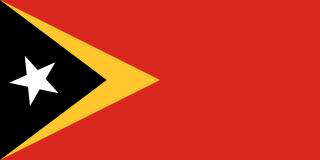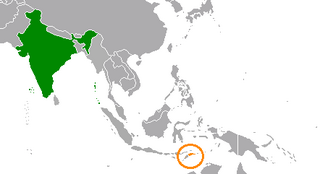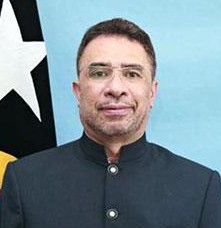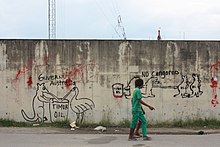
Dili is the capital and largest city of East Timor. It lies on the northern coast of the island of Timor, in a small area of flat land hemmed in by mountains. The climate is tropical, with distinct wet and dry seasons. The city has served as the economic hub and chief port of what is now East Timor since its designation as the capital of Portuguese Timor in 1769. It also serves as the capital of the Dili Municipality, which includes some rural subdivisions in addition to the urban ones that make up the city itself. Dili's growing population is relatively youthful, being mostly of working age. The local language is Tetum; however, residents include many internal migrants from other areas of the country.

East Timor, officially the Democratic Republic of Timor-Leste, is a country in Southeast Asia and Oceania. The country comprises the eastern half of the island of Timor and the nearby islands of Atauro and Jaco. The first inhabitants are thought to be descendant of Australoid and Melanesian peoples. The Portuguese began to trade with Timor by the early 16th century and colonised it throughout the mid-century. Skirmishing with the Dutch in the region eventually resulted in an 1859 treaty for which Portugal ceded the western half of the island. Imperial Japan occupied East Timor during World War II, but Portugal resumed colonial authority after the Japanese surrender.

The economy of Timor-Leste is a low-income economy as ranked by the World Bank. It is placed 140th on the Human Development Index, indicating a medium level of human development. 20% of the population is unemployed, and 52.9% live on less than $1.25 a day. About half of the population is illiterate. At 27%, East Timor's urbanisation rate is one of the lowest in the world.

The Timor Gap is an area of the Timor Sea between Australia and Timor Island. The island is divided between independent East Timor and West Timor province of Indonesia.

The Timor Gap Treaty was formally known as the Treaty between Australia and the Republic of Indonesia on the zone of cooperation in an area between the Indonesian province of East Timor and Northern Australia. It was a bilateral treaty between the governments of Australia and Indonesia, which provided for the joint exploitation of petroleum and hydrocarbon resources in a part of the Timor Sea Seabed. The treaty was signed on 11 December 1989 and came into force on 9 February 1991. The signatories to the treaty were then Australian Foreign Affairs Minister Gareth Evans and then Indonesian Foreign Minister Ali Alatas.

The Indonesian occupation of East Timor began in December 1975 and lasted until October 1999. After centuries of Portuguese colonial rule in East Timor, the 1974 Carnation Revolution in Portugal led to the decolonisation of its former colonies, creating instability in East Timor and leaving its future uncertain. After a small-scale civil war, the pro-independence Fretilin declared victory in the capital city of Dili and declared an independent East Timor on 28 November 1975.

Formally known as the Timor Sea Treaty between the Government of East Timor and the Government of Australia was signed between Australia and East Timor in Dili, East Timor on 20 May 2002, the day East Timor attained its independence from United Nations rule, for joint petroleum exploration of the Timor Sea by the two countries. The signatories of the treaty were then Australian prime minister John Howard and his East Timorese counterpart at that time Mari Alkatiri.

East Timor, also known as Timor-Leste, officially the Democratic Republic of Timor-Leste, is a country in Southeast Asia. It comprises the eastern half of the island of Timor - of which the western half is administered by Indonesia - the exclave of Oecusse on the island's north-western half, and the minor islands of Atauro and Jaco. Australia is the country's southern neighbour, separated by the Timor Sea. The country's size is 14,950 square kilometres (5,770 sq mi). Dili, on the north coast of Timor, is its capital and largest city.

Officially called the Treaty between Australia and the Democratic Republic of Timor-Leste on Certain Maritime Arrangements in the Timor Sea (CMATS), the treaty provides for the equal distribution of revenue derived from the disputed Greater Sunrise oil and gas field between Australia and East Timor. The field is located in the Timor Gap where Australia and East Timor have overlapping claims over the continental shelf or seabed. Prior to the treaty, East Timor would only have received about 18% of the revenue from the field.
This agreement is officially known as the Agreement between the Government of Australia and the Government of the Democratic Republic of Timor-Leste relating to the Unitisation of the Sunrise and Troubadour Fields.
The East Timor and Indonesia Action Network (ETAN) is a nonprofit US organization supporting human rights throughout Southeast Asia and Oceania. ETAN was founded in 1991 to support the right to self-determination of Timor-Leste. In 1999, that goal was significantly realized when the people of East Timor voted for independence. Since then ETAN has focused on building on its success in support of justice and self-determination in Timor-Leste and the surrounding region.

East Timor–Portugal relations are foreign relations between Portugal and East Timor. Timor Leste has an embassy in Lisbon whilst Portugal has an embassy in Dili. East Timor was a colony of Portugal for over 400 years. Both countries belong to the Community of Portuguese Language Countries.

East Timor and Indonesia established diplomatic relations in 2002. Both share the island of Timor. Indonesia invaded the former Portuguese colony in 1975 and annexed East Timor in 1976, maintaining East Timor as its 27th province until a United Nations-sponsored referendum in 1999, in which the people of East Timor chose independence. Following a United Nations interim administration, East Timor gained independence in 2002. Indonesia already had a consulate in Dili during the Portuguese colonial period, though Indonesia formalized their relations by establishing an embassy in Dili. Since October 2002, East Timor has an embassy in Jakarta and consulates in Denpasar and Kupang. Relations between the two countries are generally considered highly positive, despite various problems. Numerous agreements regulate cooperation in different areas. East Timorese are visa-free in Indonesia.

The Australia–East Timor spying scandal began in 2004 when the Australian Secret Intelligence Service (ASIS) clandestinely planted covert listening devices in a room adjacent to the East Timor (Timor-Leste) Prime Minister's Office at Dili, to obtain information in order to ensure Australia held the upper hand in negotiations with East Timor over the rich oil and gas fields in the Timor Gap. Even though the East Timor government was unaware of the espionage operation undertaken by Australia, negotiations were hostile. The first Prime Minister of East Timor, Mari Alkatiri, bluntly accused the Howard government of plundering the oil and gas in the Timor Sea, stating:
"Timor-Leste loses $1 million a day due to Australia's unlawful exploitation of resources in the disputed area. Timor-Leste cannot be deprived of its rights or territory because of a crime."

East Timor–India relations are the international relations that exist between East Timor and India. The Embassy of India in Jakarta, Indonesia is concurrently accredited to East Timor. East Timor has no diplomatic representation in India. On 7 September 2023, India has announced to open an embassy in Dili.
Australia–Indonesia Security Agreements are any official treaties signed by both the Australian and Indonesian Governments that concern such issues as security cooperation, defense and military involving both nations. Since 1995, five official agreements have been signed: the 1995 Agreements, the 2006 Lombok Treaty, two Defence Cooperation Agreements relating to the Lombok Treaty, and the 2014 Joint Understanding on Security.

Hernâni Filomena Maria Coelho da Silva, also known by his nom de guerreNatan, is an East Timorese politician and diplomat, and a member of the Fretilin political party. He has been the East Timorese Ambassador to both Australia and South Korea. Between February 2015 and September 2017, he was Minister of Foreign Affairs and Cooperation, and from October 2017 to June 2018 he was Minister of Petroleum.

The Government Palace in Dili, the capital city of East Timor, is the official workplace of the Prime Minister and Constitutional Government of East Timor. In the final stages of the Portuguese colonial era, it was known as the Official Palace, and was the office of the colonial governor.

The Provisional Government of East Timor (PGET),, was an Indonesian supported puppet provisional government in present day East Timor that was formed on 17 December 1975 following the Indonesian invasion of East Timor and disbanded on 17 July 1976 when the region was annexed by Indonesia as the province of Timor Timur.






















